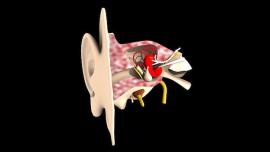Ménière's disease successfully treated with the antibiotic Gentamicin
Nausea, spinning sensation, tinnitus and hearing loss - the so-called Ménière's disease can really throw you off course. Cause is a short-term change in hydrostatic pressure in the inner ear.

As stressful as the disease is, as difficult is its treatment. In the past, in extreme cases, even the vestibular nerve was severed or the entire vestibular organ surgically removed. Treatment with a special antibiotic (Gentamicin) is much easier. By dripping the antibiotic into the middle ear, a side effect of the drug can be used therapeutically: Gentamicin reduces the excitability of the vestibular cells in a targeted and very gentle way. Scientists at Karl Landsteiner Private University for Health Sciences in Krems, Lower Austria have now re-examined 32 Austrian treatment cases between 2012 and 2015 and evaluated the results.
"Our evaluations confirm the effectiveness of this simple treatment method," explains Dr. Béla Büki, head of the outpatient department for hearing and balance disorders at the Krems University Hospital of Krems, "In over a third of the cases, only a single injection was necessary to achieve a noticeable and lasting relief of the symptoms.
The results from Austria thus confirmed other studies in which this treatment method was used therapeutically. However, in some cases the initial effect of the treatment subsided after a few months and further injections were necessary to achieve a sustained effect of the treatment. Dr. Büki and his colleague Prim. Dr. Heinz Jünger was particularly interested in whether details of the initial treatment success could be used to predict the long-term course of the effect.The effect of the treatment on the individual parts of the human equilibrium organ was also analysed. Its central part is the so-called labyrinth, which consists of three bony archways arranged in a spatially complex distribution to each other. The research-based physicians now succeeded in measuring the effect of antibiotic treatment on each of the individual arcades - and not only the overall effect. This was a differentiation that is essential for understanding the form of treatment. "In fact, our evaluation showed that the effect of the antibiotic in one channel of the labyrinth correlated strongly with its effect in the other two," Dr. Büki explains the main result of this evaluation, which now allows assumptions to be made about the nerve connections of the complex labyrinth.
For this purpose, the team evaluated data from a special measurement method that detects a human reflex, the so-called vestibulookular reflex (VOR). This compensates for rapid head movements with opposite eye movements and thus enables things to be fixed visually without problems despite the moving head. In a disturbed equilibrium system, this reflex is reduced to varying degrees and can be used as a measure of the degree of the disease or the success of treatment. In fact, by evaluating these data, it was found that the initial success of the treatment did not allow any indication as to whether another injection of the antibiotic would be necessary in a few months. The course of treatment simply has to be waited for.
The detailed analysis of a very simple form of treatment for a rare and complex disease is a notable example of research at KL Krems, which focuses on niche fields in areas relevant to health policy.
Link to publication




